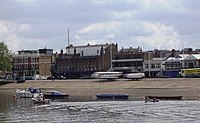Related Research Articles

Vesta Rowing Club is a rowing club based on the Tideway of the River Thames in Putney, London, England. It was founded in 1870.

The Thames Rowing Club (TRC) is a rowing club based on the tidal Thames as it flows through the western suburbs of London. The TRC clubhouse stands on Putney Embankment. The club was founded in 1860.
Timothy John Crooks is a former British rower who competed at the 1972 Summer Olympics and the 1976 Summer Olympics. He was seven times winner at Henley Royal Regatta and won the Wingfield Sculls three times.

London Rowing Club is the second oldest of the non-academic active rowing clubs on the Thames in London, United Kingdom. It was founded in 1856 by members of the long-disbanded Argonauts Club wishing to compete at Henley Royal Regatta.

Jack Beresford, CBE, born Jack Beresford-Wiszniewski, was a British rower who won five medals at five Olympic Games in succession. This record in Olympic rowing was not matched until 2000 when Sir Steve Redgrave won his sixth Olympic medal at his fifth Olympic Games.
Saint George Ashe was a British rower who competed in Rowing at the 1900 Summer Olympics in Paris winning the bronze medal in the single sculls, and won the Wingfield Sculls in 1904.
Julius Beresford (Wiszniewski) (18 July 1868 – 29 September 1959), also known as Berry or The Old Berry, was a British rower and coach. Beresford competed at the 1912 Summer Olympics in Stockholm, Sweden.
Peter Herbert "Jacko" Jackson was an English rower who competed at the 1936 Summer Olympics.

Alexander Alcée Casamajor was a British rower who won the Wingfield Sculls in six successive years and the Diamond Challenge Sculls at Henley Royal Regatta as well as being twice in the winning Grand Challenge Cup team.

Herbert Harlee Playford was a British rower who won the Wingfield Sculls and the Diamond Challenge Sculls at Henley Royal Regatta. He was instrumental in founding London Rowing Club and the Metropolitan Regatta.

Francis Playford was a British rower who won the Wingfield Sculls in 1849 and the pairs oars at Henley Royal Regatta.
Frank Lumley Playford (1855–1931) was a British rower who won the Wingfield Sculls five times and the Diamond Challenge Sculls at Henley Royal Regatta in 1876.
Jefferson Lowndes (1858–1893) was an English rower. He won the Diamond Challenge Sculls at Henley Royal Regatta five times and won the Wingfield Sculls twice.
Thomas Robson Bone (1815–1882) was an English rower who won the Diamond Challenge Sculls at Henley Royal Regatta in 1849 and 1850 and who also won the Wingfield Sculls in 1850 and 1851.
Thomas Anthony Fox was a doctor and rower who competed for Great Britain at the 1952 Summer Olympics and at the 1956 Summer Olympics. He won the Diamond Challenge Sculls and the Wingfield Sculls.
Josias Nottidge (1828–1873) was an English rower who twice won Silver Goblets at Henley Royal Regatta.
James Paine was an English rower who competed in the 19th century and won the Wingfield Sculls and events at Henley Royal Regatta.
The Thames Club was an English rowing club based on the Tideway of the River Thames that competed in the middle of the 19th century.

The St George's Club was an English rowing club based on the Tideway of the River Thames that competed in the middle of the 19th century.

King's College London Boat Club is the rowing club of King's College London based on the Tideway of the River Thames next to Chiswick Bridge, based at Tideway Scullers School boathouse, Dan Mason Drive, Chiswick, London.
